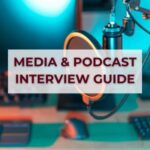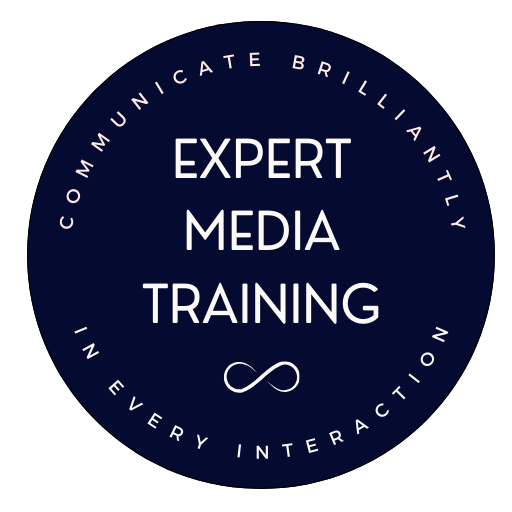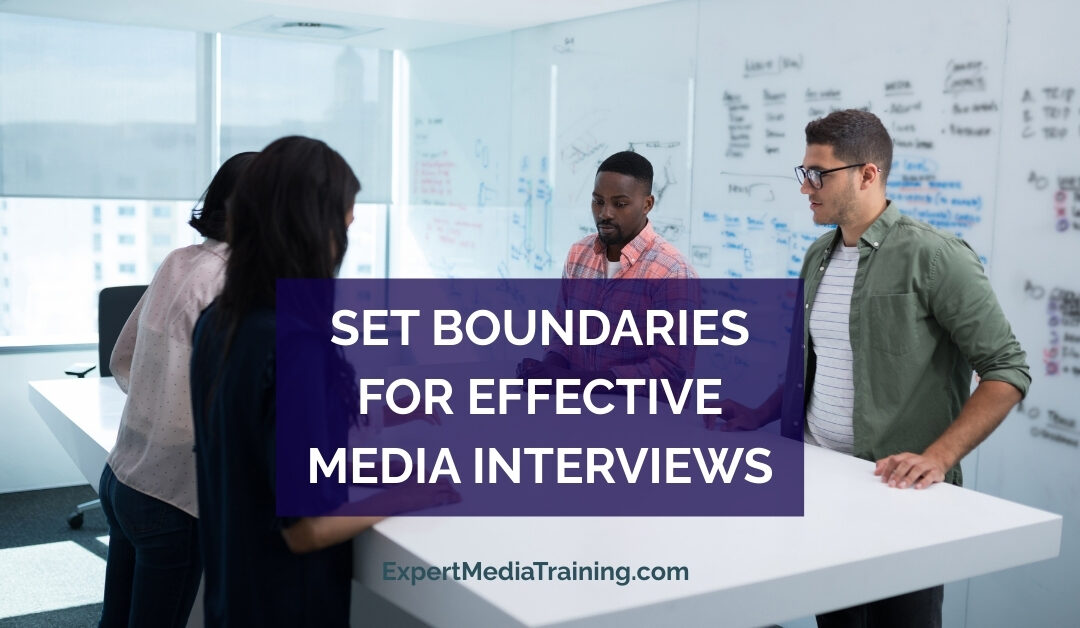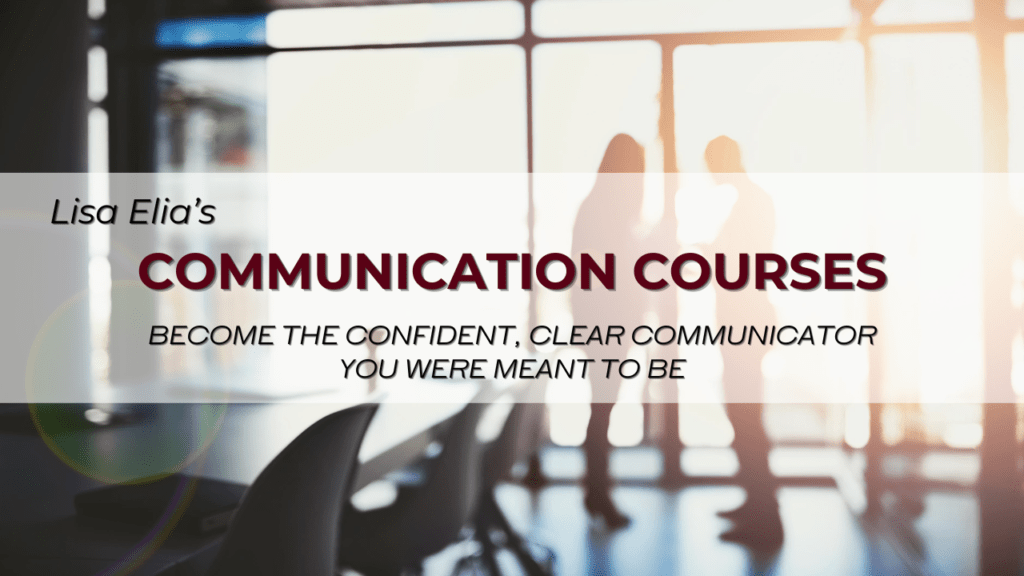Protect Your Message, Reduce Anxiety, and Align With Strategy
Fear before an interview or public appearance is often fear of the unknown—especially the “What if they ask me about ___?” spiral. One of the most effective ways to reduce that anxiety and protect your message is to set clear boundaries in advance: what you will and won’t discuss, and how you’ll respond when a line of questioning drifts outside those limits. It’s important to define this for any spokespeople who will face the media or podcast hosts. Boundaries aren’t evasive; they’re professional. They help you remain confident, conserve energy, and keep your narrative on track. For organizations, they are also essential safeguards—ensuring that spokespeople reinforce the company’s strategy and protect sensitive information.
Why Boundaries Matter
Less fear, more control (for individuals).
Uncertainty fuels nerves. When you pre-decide what’s in-bounds and rehearse responses to sensitive questions, you eliminate much of the “unknown.” Confidence rises, and you feel more in control of the narrative.
Strategic focus over time (for organizations).
Stating and maintaining boundaries doesn’t just protect one interview—it sets expectations for future ones. Journalists and audiences learn what you will and won’t discuss, which shapes the types of questions and invitations you receive going forward.
Message protection (for everyone).
Not every topic deserves more oxygen. Boundaries help avoid giving airtime to distractions or controversies. At the organizational level, this prevents confidential details, unannounced financials, or legal issues from slipping into the public record.
Brand alignment.
Every spokesperson is a steward of the brand. Boundaries ensure that individuals’ personal disclosures or offhand remarks don’t conflict with the company’s core values, messaging priorities, or long-term strategy.
Identifying your own boundaries is powerful, but the real confidence comes when you practice them under pressure. That’s why live coaching and rehearsal with feedback are such important parts of media training.
A Strategic Framework for Setting Boundaries
Click this quick-reference image to download and keep handy for future interviews.
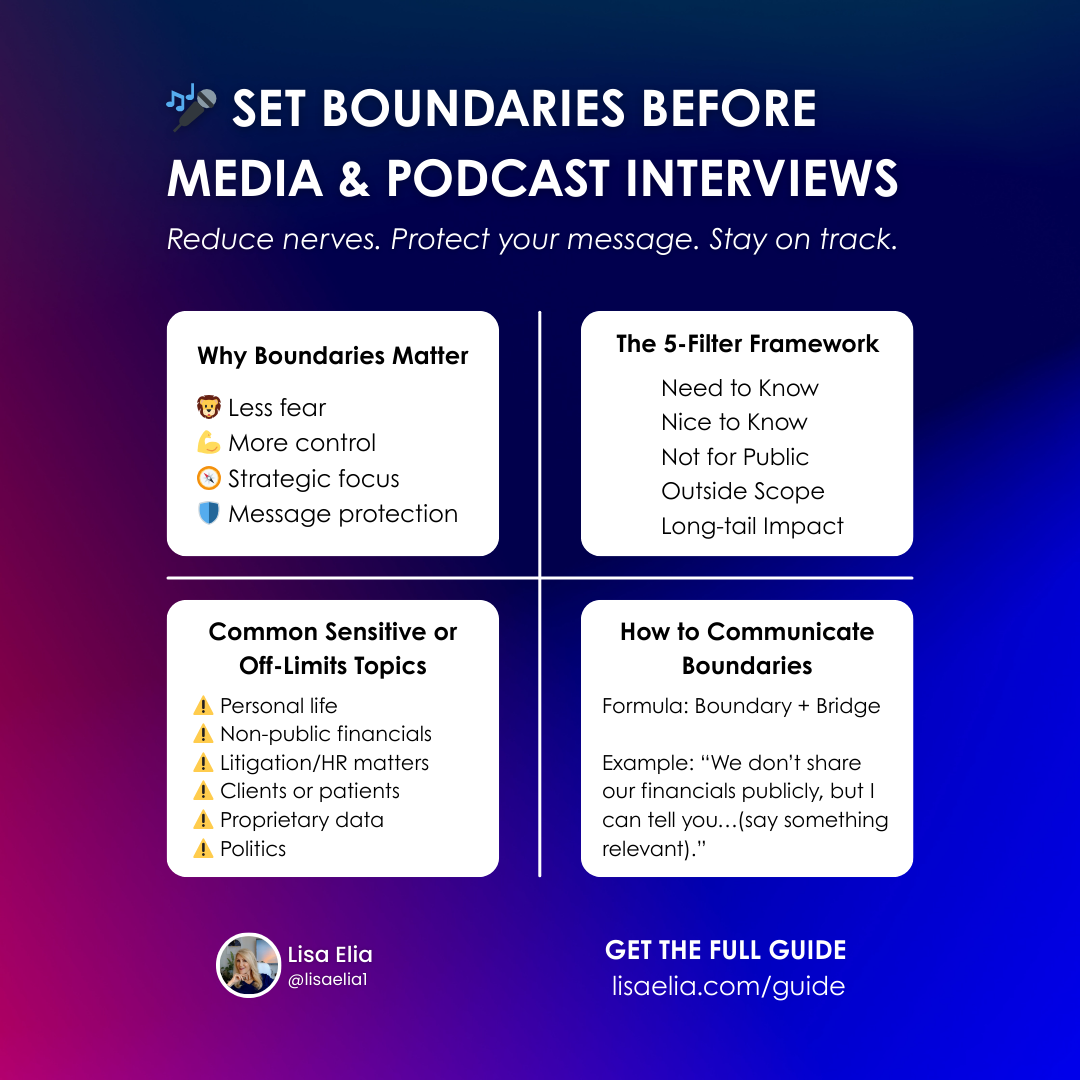
When preparing yourself—or your team—for interviews, use this five-part filter:
- Need to Know
Facts that help the audience understand your work and make informed decisions. Share these clearly and consistently. - Nice to Know
Details that are interesting but not essential. Share selectively, only if they reinforce your message and fit within strategic goals. - Not for Public Consumption
Personal matters, legal or HR issues, client confidentiality, unannounced financials, proprietary data, and other sensitive areas. Decide in advance that these are off-limits. Respond unapologetically with: “We don’t share ___.” Then, pivot to a prepared talking point. - Outside Your Scope
Be clear on what you—or your team—can speak to with authority. Anything outside your area of expertise or responsibility should be redirected to the appropriate person. This prevents speculation and maintains credibility. - Long-tail Impact
If you answer this once, are you willing to answer it again and again? Could it spark more questions you don’t want in the spotlight? Consider the ripple effect before opening that door.
This framework provides a starting point. For organizations, boundaries should be tailored to your industry, compliance requirements, and brand strategy. That’s where structured training ensures consistency with all spokespeople.
Aligning Boundaries With Company Strategy
This is where organizations often stumble. Individual spokespeople may prepare personal boundaries, but without alignment, they risk sending mixed signals. To prevent this:
- Define organizational red lines. Leadership, PR, and legal should agree on topics that are categorically off-limits (e.g., pending litigation, unannounced partnerships, internal HR matters).
- Prioritize strategic narratives. Identify the top 3–4 themes the company wants to advance in every media appearance. Boundaries should serve as guardrails that funnel conversations back to these points.
- Assign ownership. Clarify who speaks to what (CEO, CFO, subject-matter expert, etc.). If someone is asked questions outside their scope of expertise or responsibility, they should confidently redirect.
- Codify it. Document boundaries and talking points in a media guide or briefing memo so every spokesperson is aligned.
- Train for consistency. Run simulations where team members are pressed with difficult questions to practice both setting boundaries and bridging back to strategy.
Common Boundary Categories
- Personal life (family, relationship status, health)
- Financials (compensation, investor details, non-public numbers)
- Litigation, HR, or confidential internal matters
- Client, patient, or customer identities (unless you have explicit permission)
- Proprietary processes, security, or IP details
- Politics or unrelated topics that don’t serve the mission
- Anything outside professional scope or credentials
For companies: add internal alignment categories such as future product roadmaps, M&A discussions, investor communications, and regulatory matters.
How to Communicate Boundaries (Without Derailing the Conversation)
The goal isn’t to stonewall. It’s to stay composed, protect credibility, and steer back to meaningful points.
Boundary + bridge formula: state the boundary briefly, then redirect to a relevant point. Examples:
- Outside scope: “That’s outside my area of expertise, but what I can share is…”
- Confidential/proprietary: “That information is confidential, but here’s what I can say…”
- Personal boundary: “I keep my personal life private. What I can share that’s relevant here is…”
- Ongoing/legal: “I can’t comment while that’s in process. What I can address is…”
- If pressed: “Out of respect for the people involved, I won’t go into that. The important point for your audience is…”
Sample phrases can be useful, but the challenge is delivering them smoothly, without hesitation, and pivoting back to your message in real time. Practicing these scenarios in a safe environment makes all the difference.
Rehearse and Stress-Test Boundaries
Preparation transforms boundaries from theory into instinct. For both individuals and teams:
- Identify likely sensitive topics. Draft boundaries for each.
- Create bridges that connect back to strategic messages.
- Add proof points (brief examples, data, or results) to strengthen credibility.
- Role-play under pressure. Practice with colleagues or trainers playing persistent journalists to build confidence.
At the company level, include boundary-setting in crisis simulations and executive media training so responses are consistent across all spokespeople. It’s one thing to run through answers on your own. It’s another to face rapid-fire, persistent questioning that simulates real media pressure. That’s why team drills and expert feedback are essential parts of high-level preparation.
The Bottom Line
Setting boundaries is not about withholding information—it’s about serving the audience well while staying focused, confident, and aligned with your goals. For individuals, it reduces anxiety and sharpens delivery. For organizations, it protects the brand, keeps messaging consistent, and ensures every media interaction advances the strategy rather than derailing it.
Beyond Boundaries: Total Communication Readiness
Boundaries aren’t just about protecting information—they’re about protecting your credibility. With expert training, you or your team can walk into any interview knowing exactly how to respond with composure and alignment. Just as important, we focus on elevating overall communication skills and establishing preparation rituals that calm nerves, sharpen focus, and ensure you step into every appearance with confidence and clarity.
To strengthen your skills—or prepare your team to stay on message—set up a complimentary consultation with Lisa Elia: https://calendly.com/emt-appt/consultation-with-lisa-elia
For more strategies to prepare for interviews, download my free Media & Podcast Interview Guide.
To download our free Media Interview Guide and other tools, click here.
To check out our online courses, click here.
For a complimentary consultation to discuss private training for yourself or your team, click here.

This post was written by Lisa Elia, a media trainer, presentation trainer, pitch coach, communication expert, and speaker. She trains clients around the world for media interviews, speeches, internal and external presentations, panels, investor presentations, and promotional videos, and provides executive and team communication coaching.
With more than 25 years of experience, Lisa has prepared clients for interviews with TODAY, GMA, The Wall Street Journal, CNN, ESPN, and hundreds of other outlets. Lisa has shared her expertise with national media outlets that include Inc., Entertainment Tonight, E!, and many others. Clients include entrepreneurs, Fortune 500 companies, and everything in between as well as athletes, celebrities, and other public figures.

